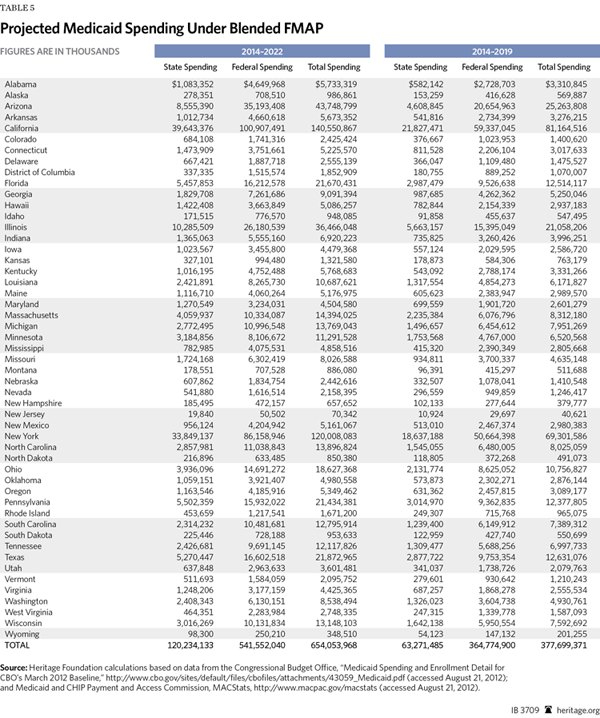Under the Supreme Court’s ruling on the Affordable Care Act (ACA), states may choose to expand their Medicaid populations to include individuals below 138 percent of the federal poverty level, with the federal government picking up 100 percent of payments for the first three years and then rolling back federal payments. This structure is designed to be attractive to the states, since it appears to increase health coverage at little or no state-level cost.
However, the expansion would be very expensive to states as early as 2019. In his fiscal year (FY) 2013 budget, President Obama has already proposed reducing the federal match rate on the expansion.[1] Many states are already struggling with Medicaid spending. The blended rate proposed in the Administration’s budget would make matters worse, costing states up to $3.4 billion a year.[2]
Changes to the Federal Match Rate: Several Scenarios
States could experience a wide range of increased costs if federal match rates are reduced. Using the Heritage Health Insurance Microsimulation Model,[3] several scenarios were simulated.
In the first scenario, the federal match rates are set according to the ACA. In the first three years of the ACA, the federal match rate is 100 percent, gradually rolling back to 90 percent by 2020. Each following alternative scenario reduces the federal match rate in some other fashion.
In the second scenario, a flat 90 percent federal match is assumed. In the third scenario, the match rate is reduced by 10 percent but keeps the same schedule as described in the ACA. In the fourth scenario, the match rate is reduced to a level that can be called the “blended rate”—an estimation of what the match rate could be under the Administration’s suggestion.[4] This blended rate is an average of a state’s current Medicaid match, its enhanced match rate for the Children’s Health Insurance Program, and the expansion match rate. The result of this scheme is a drastic reduction in federal spending at the expense of the states.
While these scenarios do not capture potential (although uncertain) savings from less uncompensated care or increased tax revenues, what is certain is the cost of adding millions of individuals to Medicaid in the expansion.
For example, Ohio would see increased spending in the first five years by $407 million and an increase on the budget by around $1 billion total by 2022 in the first scenario. Under a flat 90 percent match rate, costs increase from $407 million to nearly $1.3 billion in the first five years. Under the blended rate, costs increase to $2.5 billion in the first five years.
The story is similar for Illinois, with increases in spending by $840 million in the first five years and spending of about $2 billion by 2022. Under the blended rate proposed in the fiscal budget, Illinois’s costs increase to $6.7 billion in the first five years.
In Georgia, spending could increase by $200 million in the first five years and by $500 million by 2022 under the ACA. However, if the match rate is lowered for the expansion population, costs could jump to $1.2 billion in the first five years.
Remain Forward Looking
The Administration is selling the Medicaid expansion as a great benefit to the states, since the federal government foots a majority of the bill in the first years of implementation. However, even under the ACA, the expansion will begin putting pressure on state budgets as early as 2019.
State legislators cannot afford to be myopic when assessing the costs and benefits of expanding Medicaid. Aside from problems already apparent in Medicaid, such as patient access, states must also face uncertainty in how much the expansion will actually cost.[5] The Medicaid expansion represents a giant increase in federal spending of $642 billion, according to the Congressional Budget Office.[6]
Instead of adding millions to Medicaid, Washington should reform the program. The Heritage Foundation’s Saving the American Dream does just that.[7]
Drew Gonshorowski is Policy Analyst in the Center for Data Analysis at The Heritage Foundation.







